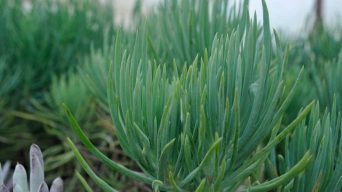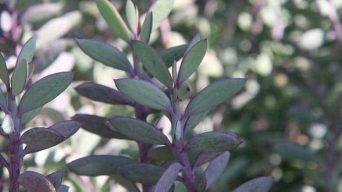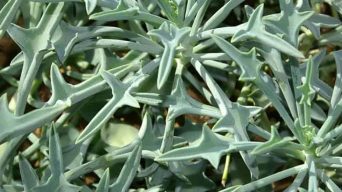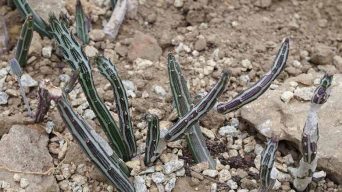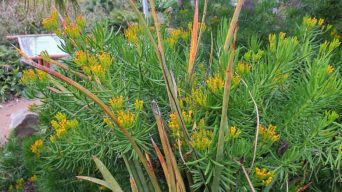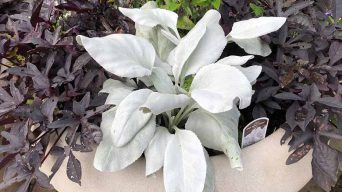Senecio talinoides, currently known as Curio talinoides, is a beautiful succulent perfect for beginners and experts alike.
The Senecio talinoides plant requires very little care, making it an excellent addition to any home or office space looking for some greenery!
This guide will teach you everything you need to know about Senecio talinoides care and how to propagate them in the long term so they can grow and thrive in your garden and home.
Overview
Senecio talinoides, currently known as Curio talinoides, is a flowering plant of the Asteraceae family that is native to South Africa.
This succulent spreads up to 3 ft (90 cm) wide and grows up to 2 ft (60 cm).
The Senecio talinoides is a succulent plant featuring beautiful green to matt green leaves. They are upright and slightly curved, with pointed ends that measure up to 6 inches long.
The stem of a Senecio talinoides succulent plant is typically erect before it becomes prostrate. It usually roots at the nodes where stems touch the ground.
This flowering plant has small white flowers that grow in clusters and bloom in spring.
Some of the names by which Senecio talinoides or Curio talinoides is commonly known are:
- Narrow-leaf Chalk Sticks
- Blue Chalk Stick
- Blue Straws
- Blue Finger
How To Care for Senecio Talinoides (Narrow-leaf Chalk Sticks)
Senecio Talinoides (Narrow-leaf Chalk Sticks) care is not difficult. Still, certain environmental conditions need to be met.
Below you will find the main things to consider when taking care of your Senecio.
Sun Exposure & Light Requirements
The Senecio talinoides is a succulent plant that generally thrives in places with bright indirect light.
When planted indoors, the Senecio talinoides should be grown with indirect but bright morning sunlight without any direct sun at all.
When grown outdoors, it should be in a partially shaded location.
It should not be placed in direct sunlight, as this Senecio talinoides succulent plant is very sensitive to high levels of sun exposure.
This type of succulent is best grown outdoors in a partially shaded location rather than indoors.
Outdoors, the Senecio Talinoides should grow well on slopes and flat areas if planted in partial shade.
To care for the Senecio Blue Chalk Stick plant indoors, it should be positioned in front of an east-facing window and receive light from the morning sun.
It can also live near a south-facing window, but only if it is not receiving direct sunlight during the morning.
Watering Requirements:
Watering Senecio talinoides plants once a week is usually enough.
Some succulent enthusiasts will water them twice or even three times per week during the summer when they are actively growing and producing more leaves than usual.
The soil may need to be watered less often if the humidity in the air is high or if you keep your Senecios indoors near a humidifier because of low light levels outdoors.
As a general rule, the Senecio talinoides plant should only be watered when the soil is dry.
If the soil becomes too wet, it will not be able to drain, and plants won’t survive.
To test whether water is needed or not, feel the top of the soil with your fingers before watering. Water isn’t necessary if you can still squeeze a drop out when you poke in it.
Soil Requirements
The Senecio talinoides plant typically requires well-draining soil that is made primarily of sand. It needs well-aerated, porous soil to ensure that the Senecio talinoides plant can access air and water.
A cactus/succulent potting mix will work well for Senecio talinoides plants because it is made primarily of sand and has a small amount of organic matter in the mix.
You can also use a Senecio talinoides soil mix, including some compost, to help with plant drainage, aeration, and nutrients.
No matter what type of potting mix you decide on using, make sure that your Senecio talinoides plant’s container drains very well because this succulent does not like sitting water at its roots.
Temperature and Humidity
The ideal temperature range for Senecio talinoides is between 16 to 24 degrees Celsius (or 63 to 75 degrees Fahrenheit) during the daytime hours and much cooler at night, around 12 C (53 F).
This Senecio species should not be exposed to temperatures below 12 C (53 F).
Do not expose your Senecio talinoides to temperatures above 35 C (95 F), or else the Senecio may get sunburned.
The Blue Chalk Sticks plant grows well, with humidity levels around 50%. If the air is too dry, you can mist it occasionally or set up a humidifier nearby.
If the air is too humid, your Senecio plant will grow mold.
Fertilizing
The Senecio talinoides succulent does not require fertilizer, as it thrives in an environment with little water and high temperatures.
However, there are some circumstances where fertilization may be required or desired.
Fertilizing should be done at least once a year or whenever there’s noticeable, Senecio talinoides succulent foliage discoloration or wilting caused by nutrient deficiency.
You should also fertilize your plants about once per year in the summer if you want them to grow quicker.
Using a dilute solution of a balanced, water-soluble fertilizer is best.
Organic, water-soluble fertilizer is also an acceptable option.
If you are going to fertilize the plant with a diluted fertilizer solution, then use about one teaspoon per gallon of water.
It is best not to fertilize your plants every time you water them because it can lead to heavy salt build-up on the soil surface and root rot if too much salt has been applied.
Doing so will result in stunted growth if this excess salt isn’t washed off regularly.
Potting and Repotting
After a Senecio talinoides has outgrown its pot, it’s time to repot the plant.
The size of the pot will depend on how large your Senecio needs to be spread out to grow properly.
If you are unsure of what size plant would fit best into your garden space, consider starting with a larger one, so it has more room to grow as time goes by.
When picking a new home for your Senecio, avoid getting anything too deep because this succulent requires plenty of air circulation at all times. A shallow container like an old baking tray can work amazingly well!
Begin filling the bottom half of the pot with soil about two inches (five centimeters) thick.
Next, remove your Senecio talinoides plant from its old pot and gently shake off any excess soil.
Place the Senecio root side down into the new container to sit at an angle with only a small portion above ground level.
Fill around the Senecios roots with more soil until they are covered up to just below where you took them from their old home.
Water the Senecio’s soil thoroughly once before placing it back on top of your dirt-filled baking tray.
This will help settle everything nicely together and make sure that there aren’t any air pockets left underneath!
Repeat this process every time you move your Senecio to a new pot.
You should rotate the Senecios after they are repotted so that all sides will be equally exposed to light and air. This helps them grow more evenly and symmetrically.
Pruning
Pruning Senecio talinoides is a great way to keep it in shape and healthy.
Prune Narrow-leaf Chalk Sticks by grabbing the stem at the base of an out-of-control branch or leaf, then snip off unwanted parts using sharp gardening scissors.
It will benefit from removing any dried leaves, dead flowers, or branches falling over other plants on your windowsill.
When pruning Narrow-leaf Chalk Sticks for these reasons, cut back into live tissue so that new growth can continue without interruption.
You may also want to give Senecio talinoides a haircut if it becomes too unruly with long stems. Cut them near ground level when they become leggy.
Senecios should be pruned every few months to keep them looking healthy and well-manicured.
Pests and Diseases
Pests and diseases threaten Senecio talinoides, making them weaker, unhealthy, or even killing the plant.
Several pests like aphids, mealybugs, thrips, spider mites, fungus gnats (typically found in soil), and leaf miners (also called wormholes) all feed on Senecio plants in different ways.
Two diseases can harm Senecio plants, Seneciosis and Leaf Spot.
The best way to prevent pests and diseases is to take care of your Senecio talinoides plant.
The best way to do this is by providing appropriate light, adequate watering, and enough room.
If any pests or diseases do occur, they can be removed with a Q-tip dipped in rubbing alcohol for aphids and soap and water for mealybugs.
Thrips and fungus gnats are typically taken care of by spraying the plant with a high-pressure hose. At the same time, leaf miners will disappear without needing to be treated.
For Seneciosis, you should allow the affected leaves to dry out before disposing of them so that no more spores from Seneciosis end up infecting other Senecio plants.
For Leaf Spot, you can cut out the infected leaves and destroy them, as well as using a fungicide.
How to Care for Senecio Talinoides (Curio Talinoides) in Winter
Senecio talinoides (Curio talinoides) winter care is a relatively straightforward process.
Narrow-leaf Chalk Sticks need protection from the cold (below 50 degrees F).
Senecios are frost-sensitive plants which means they will become damaged when exposed to temperatures below freezing for an extended period.
The key to winter care is keeping the plant at 50-55 degrees F. (Soil should be kept 70 degrees F)
To ensure that Senecio talinoides succulent plants don’t get damaged during the winter months, here are some tips:
- Place your Narrow-leaf Chalk Sticks in an area with low humidity and drafts, such as a basement or garage, away from doors that might let hot air leak out. If this isn’t possible, move the potting soil location to a warmer area, such as the garage.
- Don’t overwater to avoid root rot and keep water from freezing in your Senecio potting soil; watering once or twice during long periods of cold weather is enough.
- In the coldest months, Senecio plants may need protection against high humidity.
- If you cannot overwinter your Senecios outdoors, it would be wise to move them inside and keep them in a container with drainage holes or potting soil so they don’t freeze.
- To ensure that Senecio talinoides succulent plants stay healthy all year round, make sure they get at least four hours of light per day.
How To Propagate Senecio Talinoides (Narrow-leaf Chalk Sticks)
Senecio talinoides (Curio talinoides) can be propagated by seeds or cuttings.
Seeds
Seeds can be collected in the late summer when Senecio talinoides (Narrow-leaf Chalk Sticks) are ripening.
They should not be allowed to fall from the plant into a compost pile as they will rot and mold.
Instead, shake them off mature plants onto sheets of paper or cardboard placed on the ground below.
Place the seeds where there is good drainage so that water does not pool around them, and cover with another sheet of cardboard for protection against rain.
Keep moist until germination by spraying gently with a hose or misting every day – this may take up to fifteen days or more, depending on temperature and weather conditions.
The best time for propagation through seeds is in late summer when Senecio talinoides are ripening.
Cuttings
When Senecio talinoides are actively growing in late winter or early spring, cuttings can be taken.
The cuttings should be taken from the mother plant with a sharp, sanitized knife and should be at least six inches long.
Allow the cuttings to callous for a few days before planting them in moist, well-drained soil.
Keep the soil moist until the cuttings are established, which may take up to six weeks, depending on growing conditions and weather.
Is the Senecio Talinoides (Curio talinoides) Toxic?
The Senecio talinoides succulent plant is considered toxic to humans and pets. Senecio talinoides is a type of Senecio which is often considered toxic to humans.
It is always recommended to wear gloves when handling the Senecio talinoides succulent to avoid contact with any of its oils.
Skin irritation may occur if skin comes in contact with Senecio talinoides, so it is recommended that you wash your hands thoroughly after handling this plant.
Keep away from small children, pets, and livestock.
Final Thoughts
Senecio talinoides is a beautiful succulent plant that can be seen in many gardens.
They are easy to care for and propagate.
They are great for indoor or outdoor use and offer versatility to gardeners of all levels.
This plant is perfect for those looking to add some color and life to their space without a significant commitment.


